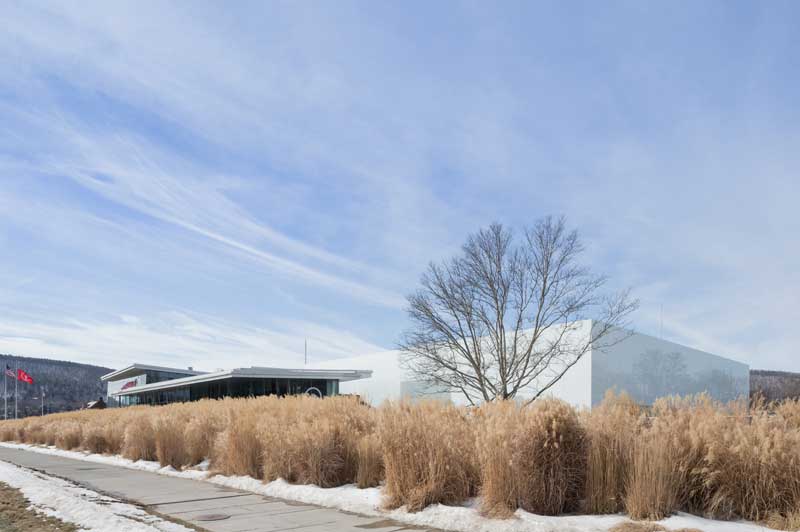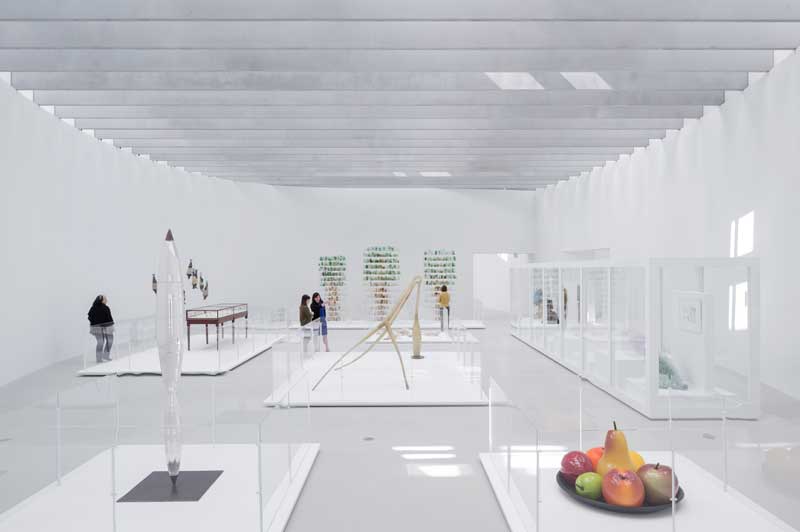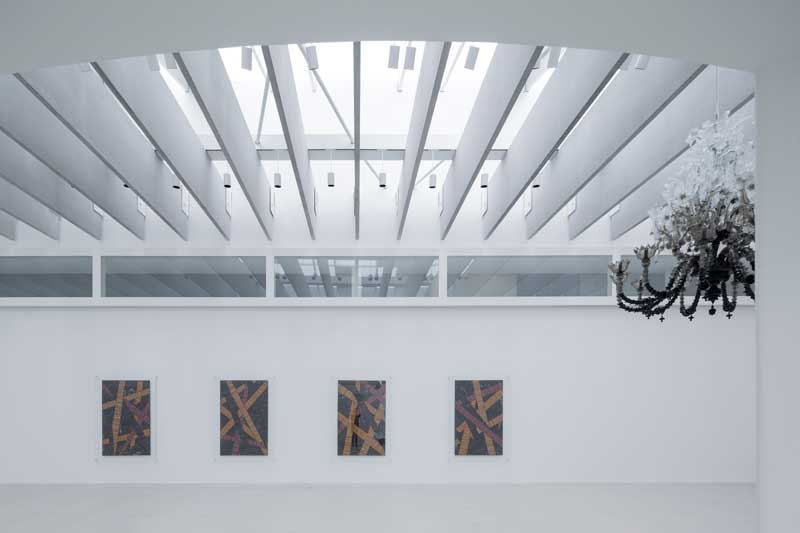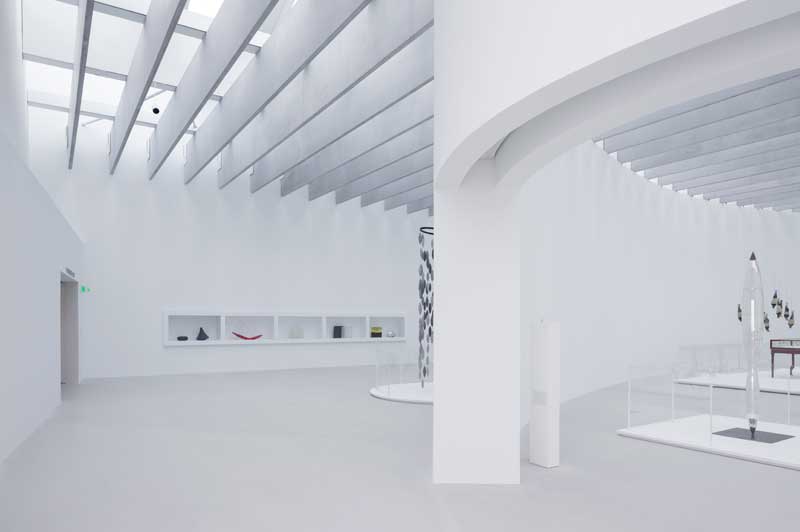The Corning Museum of Glass opens a new wing devoted to contemporary work this week. The 26,000 sq ft gallery is the largest such space in the world, and brings the museum’s impressive historical collection thoroughly up to date. A group of new acquisitions will join the existing holdings. We asked the curator, Tina Oldknow, to tell us more about the project.
The front of the Corning Museum of Glass, featuring the new Contemporary Art + Design Wing, designed by Thomas Phifer and Associates. Photo by Iwan Baan. Courtesy of the Corning Museum of Glass

Tell us a bit about the new Contemporary Art + Design Wing. How does it complement and tie in to the rest of the Corning Museum’s collection?
The Contemporary Art + Design Wing, dedicated to art and design in glass dating from 1990 to the present, is a much needed addition to the museum. Over the past 25 years, the amount of work made in glass has increased dramatically, and the museum has expanded in order to allow us to present contemporary pieces – first in 1993, and again in 2015. Like most museums, the Corning Museum of Glass was challenged with too little space, and several artworks in the collection were too large to be displayed.
Architectural detail, Corning Museum of Glass Contemporary Art + Design Wing, designed by Thomas Phifer and Partners. Photo by Iwan Baan. Courtesy of the Corning Museum of Glass

Situated on the north side of the museum, the new Contemporary Art + Design Wing presents both contemporary artworks and artists, who work publicly in the new amphitheatre. The south side of the museum houses the historical galleries, which start at the very beginning of glass vessel making – in Egypt around 1500 BC – and continue into the 20th century. Our modern glass gallery dates from 1900 to 1975, while our Ben W. Heineman Sr. Family Contemporary Glass Gallery covers the period from 1975 to 2000. There is a 10-year overlap between the ‘historical’ contemporary gallery and the new Art + Design galleries to encourage the chronological connection between the two. The Heineman Gallery shows the development of glass as a material for art as a result of the international Studio Glass movement, while the new galleries present the innovative directions that art in glass is taking now.
You’ve recently acquired some exciting works for the new space. Could you talk us through the contemporary acquisitions process – how do you decide what to collect or which artists to approach?
Acquisitions happen in so many ways, and each artwork has its own story. Like most curators, I keep a wish list of the objects I believe the institution needs. I am always thinking about potential acquisitions, and I usually (but not always) watch an artist’s career develop for three or four years before bringing their work into the museum’s collection. The museum often buys works from galleries or, more rarely, at auction. Sometimes something pops up that wasn’t on the wish list, but is interesting for the museum to have. Acquisitions can take a couple of years, or they can take a couple of months.
Sometimes artists are commissioned by the museum to make a work, and the museum has its annual Rakow Commission, which encourages artists – emerging or established – working in glass to venture into new areas that they might otherwise be unable to explore because of financial limitations.
The Corning Museum of Glass’s new Contemporary Art + Design Wing, designed by Thomas Phifer and Partners. Photo by Iwan Baan. Courtesy of the Corning Museum of Glass

A few of the new acquisitions – particularly Klaus Moje’s mosaic piece – seem to revive or rethink old traditions. Is there still a sense of continuity between today’s glassmaking and that of the past?
Certainly, there is a sense of continuity, and people like to talk about how glassblowing is relatively unchanged from how it was practiced in ancient times. But, to be accurate, glassforming has changed a lot, with very sophisticated equipment and many artists developing new techniques for the material. While ‘mosaic’ glass – which involves fusing glass into patterns and then forming it – is an ancient technique, Klaus Moje has completely rethought and recontextualised it, helping to develop the colour-compatible glass he uses to realise his vision, as well as evolving the technique from the creation of vessels to the creation of glass paintings.
‘The Portland Panels: Choreographed Geometry’ (2007), Klaus Moje, and ‘To Die Upon a Kiss’ (2011), Fred Wilson. Photo by Iwan Baan. Courtesy of the Corning Museum of Glass

You’ve written a new catalogue on Collecting Contemporary Glass. Has public interest in – and the market for – such items changed much in recent years?
There is a strong market for contemporary glass, and a secondary market is developing. The 1980s and 1990s were dominated by collectors whose interests tended to be glass- and ceramic-specific. Whereas now, I see glass being integrated more into contemporary collections of painting, sculpture, and design. Glass is recognised as a material for craft and design, and what I show in the new galleries – as well as in the book – is that, while it is craft and design, it is also contemporary painting, sculpture, and installation art. In fact, the most interesting work in glass today is large-scale and sculptural.
The new wing is devoted to ‘Contemporary Art + Design’. How do you distinguish between these two categories – or do you try to bring them together?
Design is meant to be functional, and scaled to human use, while art is generally nonfunctional and can be any scale. In the new wing, design is shown in a gallery separate from art. Clearly, large-scale sculptures are very different from a vase or a chair. The museum does have one installation made of commercial drinking glasses and several chandelier-based sculptures, not to mention works created out of vessel forms. So there is some interesting conceptual crossover. The field of design has dramatically changed in recent years, expanding out of its traditional categories. The new design gallery contains work that is design and even craft, but also work that may be understood as art, for example the design art of Studio Job in Belgium.
The Corning Museum of Glass’s new Contemporary Art + Design Wing, designed by Thomas Phifer and Partners. Photo by Iwan Baan. Courtesy of the Corning Museum of Glass

The new Contemporary Art + Design Wing opens at the Corning Museum of Glass, New York, on Friday 20 March.


